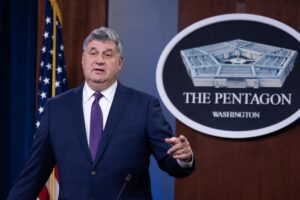The Pentagon is now on track to be able to build 100,000 155mm artillery rounds by 2025, a nearly fourfold increase from current capacity, the department’s acquisition chief said on Friday.
The update follows the Army’s recent comments it was aiming for 80,000 rounds per month by that same date, with Under Secretary of Defense for Acquisition & Sustainment Bill LaPlante citing the department’s new Joint Production Accelerator Cell (JPAC) as critical to assisting expansion efforts.

“We’re being mindful as we fund the [effort] as we get up to 100,000 [155mm ammo rounds] per month by 2025…that we’ll be producing more than, I don’t know, historically has been produced in decades. But we’re also doing it in line with the world situation,” LaPlante said during a Center for New American Security discussion.
Doug Bush, the Army’s top acquisition official, told reporters in early August the service was nearing capacity to build 28,000 155mm artillery rounds per month as it worked toward the 80,000 per month target for fiscal year 2025 to replenish its own stockpiles and continue supporting Ukraine (Defense Daily, Aug. 7).
LaPlante noted on Friday the 28,000 number is already double the production rate from earlier this year, and that the Pentagon will be at 57,000 rounds per month by next spring and closer to 65,000 per month a year from now.
The new JPAC, which LaPlante first detailed earlier this year and said on Friday was an “operational cell of production expects,” has been working with the services how to expand manufacturing capacity for 155mm ammunition as well as Stinger and Javelin missiles, GMLRS rockets, HIMARS launchers, PAC-3 MSE interceptors and AIM-9X weapons.
“All those expansion [efforts] you’re seeing is the JPAC working with the services or sometimes on their own to get that to happen,” LaPlante said.
LaPlante said JPAC’s work includes working through data on how to best manage long-lead items for critical munitions to assist industrial base planning efforts.
Building on the group’s initial work on efforts to boost munitions production capacity, LaPlante said on Friday he’s now tasking JPAC with looking into assisting a broader array of programs.
“I’ve started to use them for other things beyond munitions. I sent them down, with the Air Force, to the F-16 production line down in South Carolina. I want them to take a look at the hypersonics production lines that are being set up in Texas by Lockheed Martin [LMT]. You can see this is really, really important. And [the JPAC is] invaluable,” LaPlante said.
LaPlante said that he specifically sent the JPAC to check the F-16 line partially due the backlog of transferring the fighter jets to Taiwan, with the aim of getting that production line up to producing four aircraft per month.
Rep. Mike Gallagher (R-Wis.), chair of the new House Select Committee on China, urged Congress earlier this year, after returning from a trip to Taipei, to address the reported $19 billion backlog of FMS cases with Taiwan, which includes an $8 billion deal approved in August 2019 for dozens more F-16s (Defense Daily, Feb. 24).